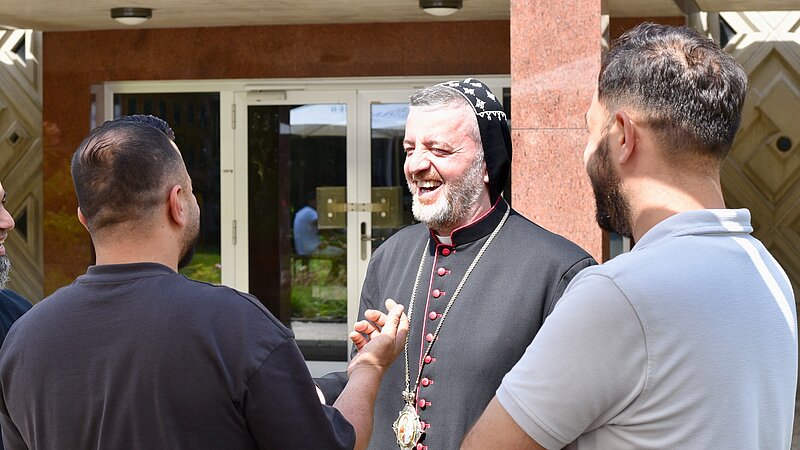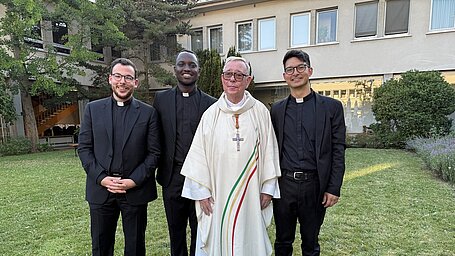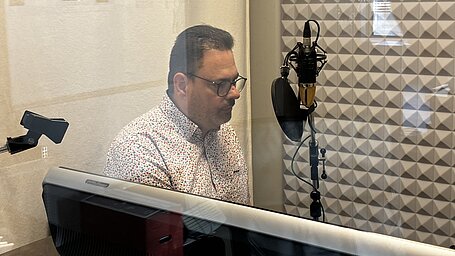
Mor Polycarpus: "The Orthodox Church has a poetic approach to the truths of faith."
Interview with the Metropolitan of the Syriac Orthodox Church in the Netherlands.
While at the Jean XXIII Centre for a working meeting with the Luxembourg School of Religion & Society (LSRS), I had the good fortune to meet Mor ([1]) Polycarpus Augin Aydin. Mor Polycarpus is Metropolitan and Patriarchal Vicar of the Archdiocese of the Netherlands of the Syriac Orthodox Church. The day before, he had given a lecture in Trier as part of the 1700th anniversary of the Council of Nicaea, at the invitation of Professor Annemarie C. Mayer, who is also an associate professor at the LSRS. Canon Jean Ehret, director of the LSRS, who was present in Trier, invited Mor Polycarpus to come and discover the LSRS. The Metropolitan was kind enough to grant me an impromptu interview.
Your Eminence, yesterday you gave a lecture on the Council of Nicaea. How important is the 1700th anniversary of this council for Christians?
Mor Polycarpus. The Council of Nicaea, convened by Emperor Constantine in 325, was a decisive moment in the history of the Church. It addressed critical theological and ecclesial issues, laying the foundation for a unified Christian identity. Most notably, it produced the first ecumenical Creed, affirming the divinity of Christ and establishing a shared confession of faith that would shape Christian doctrine for centuries to come. Over time, this Creed was woven into the fabric of the Church’s liturgical life. In the Syriac Orthodox tradition, for example, we recite the Creed at the conclusion of every prayer in the Liturgy of the Hours, as well as during the Divine Liturgy, so that it becomes a living hymn of our faith in the triune God—Father, Son, and Holy Spirit.
Another enduring legacy of the Council of Nicaea was the decision to establish a unified date for the celebration of Easter. This was of vital importance for preserving the unity of the Church, as it ensured that Christians throughout the world would celebrate the central mystery of their faith—the Resurrection of Christ—on the same day.
This 1700th anniversary invites us not only to reflect more deeply on the theological content of the Creed but also to renew our commitment to visible unity.
Can this anniversary be an opportunity for the different Christian Churches to come closer together?
It is a time to move forward together. 20 May 2025 marked the start of the celebrations for the 1700th anniversary. Representatives of the Protestant, Greek, and Oriental Orthodox, and Catholic Churches met in Nicaea. Pope Francis had planned to go to Nicaea to discuss the conditions under which we could set a common date for Easter. It is said that Leo XIV may go there in November.
This year we celebrated Easter on the same day. The difference in date between the Catholic and Protestant celebrations on the one hand, and the Orthodox celebration on the other, is only a matter of calendar, not a theological issue. Finding a path to unity would be a beautiful way to honour the conciliar fathers of Nicaea. In practical terms, the Julian calendar had certain limitations, but the Gregorian calendar is not completely accurate either. It is certain that Easter must be on a Sunday, but as Pope Francis said, we are not celebrating a calendar, we are celebrating the resurrection!
What advantage do you see in having a common date for Easter?
From both a theological and pastoral standpoint, a shared date for Easter would be a visible expression of Christian unity and would strengthen the Church’s witness in the world. I am often asked whether we truly believe in the same Christ as other Christians—namely, Catholics and Protestants—given that we do not even celebrate the Feast of the Resurrection on the same day. A common date would help dispel such confusion and affirm our shared faith in the risen Lord.
It would also be of great benefit to families in interchurch marriages—whether Catholic-Orthodox or Protestant-Orthodox—who long to celebrate together the central mystery of their faith. On a practical level, a unified Easter date would simplify holiday planning for schools, workplaces, and families, and would facilitate the coordination of Church events and public expressions of faith.
What are the major challenges facing the Syriac Orthodox Church in the Netherlands?
One of our pressing concerns is the integration of Syriac Orthodox refugees from war-torn regions. Many arrive traumatised, having lost family members. Their children grow up amid uncertainty in a culture and climate vastly different from their own. Some risk falling into crime, and we are seeing a rise in family breakdowns and divorce. We work hard to help these families regain a sense of stability, navigate their new environment, and find meaning and purpose. The greatest challenge is one of identity—many have come to the painful realization that they will not be returning to their homelands in Syria, Iraq, or Lebanon anytime soon, and must now find a way to forge a new path and sense of belonging in their new environment.
In terms of faith, many Catholics say they no longer believe in the dogma of the real presence of Christ in the Eucharist. Are you confronted with similar phenomena in the Syriac Orthodox Church?
The question of dogma ultimately hinges on how it is communicated. Some dogmas have clear historical foundations and are more readily accessible to the faithful. Others are more abstract and require a different approach to be fully appreciated. Should we explain them in scientific, rational terms—or through the lens of faith and spiritual insight? In the Syriac Orthodox Church, we often turn to poetic and symbolic language to convey the deeper truths of the faith.
Take baptism, for example. In our tradition, the baptismal font is likened to the womb of a spiritual mother from which sons and daughters are born anew. Through baptism, they are clothed with the garment of glory that Adam and Eve lost in Paradise. As the newly baptized emerge from the waters of rebirth, they are immediately brought to the holy altar to receive the Eucharist. In that moment, the priest proclaims: “The fruit which Adam did not taste in Paradise is today placed gladly in your mouth.”
This kind of symbolic and richly evocative language helps the faithful grasp theological realities not only with the mind but also with the heart, allowing them to internalize the mystery in a deeply personal and spiritual way.
I am particularly fond of the work of American writer Kathleen Norris. She spent time in monastic retreat at Saint John's Abbey in Minnesota and chronicled her experience in The Cloister Walk. In Amazing Grace: A Vocabulary of Faith, she reflects on the vocabulary of belief through personal stories, making complex concepts accessible. As she suggests—and I agree—just as you don’t wait until you're fully ready to start praying, some truths must be believed before they can be fully understood.
[1] 'Mor' is a Syriac honorific title meaning "My Lord." It is traditionally used as a form of respectful address for bishops, saints, and other high-ranking clergy in the Syriac Orthodox Church and other Syriac Christian traditions. Rooted in the Aramaic language of Jesus and the early Church, the title conveys both spiritual authority and affectionate reverence.
Why don't all Christian churches celebrate Easter on the same date?
For all Christians, Easter, the Resurrection, is the high point of the liturgical year. The Council of Nicaea in 325 settled the question of the date of the feast, setting it on the first Sunday after the full moon following the spring equinox. At the time, the Julian calendar was the standard. However, this calendar, created by Julius Caesar, made the year eleven minutes too long. In 1582, Pope Gregory XIII removed ten days and reformed the calendar. Western churches adopted the Gregorian calendar, but the Orthodox Church retained the Julian calendar. All Christian churches calculate Easter according to the rule of the Council of Nicaea, but apply it to two different calendars, which can cause differences.
Merci, datt dir dësen Artikel gelies hutt. Falls dir wëllt iwwert d'Aktualitéite vun der Kathoulescher Kierch zu Lëtzebuerg informéiert bleiwen, dann abonnéiert Iech fir d'Cathol-News, den Newsletter, deen all Donneschdeg erauskënnt, andeems dir hei klickt.
Headlines
-
Mor Polycarpus: "The Orthodox Church has a poetic approach to the truths of faith."
Interview with the Metropolitan of the Syriac Orthodox Church in the Netherlands.
-
Für die Bildung in Unterscheidung
Beten wir, dass wir lernen immer mehr zu unterscheiden, die Lebenswege zu wählen wissen und all das abzulehnen, was uns von Christus.
-
Eng lescht diözeesan Roumrees vum 31. August - 6. September 2025
Als Pilger vun der Hoffnung wëlle mir äis am Jubiläumsjoer mam Bus eng leschte Kéier an d’Helleg Stad op de Wee maachen, fir e Stéck Weltkierch ze…
-
Mgr. Coppola: „Der Heilige Vater braucht unsere Gebete“
Der Nuntius feierte das Pontifikalamt anlässlich des Amtsantritts von Papst Leo XIV.





